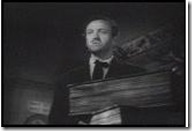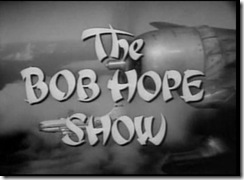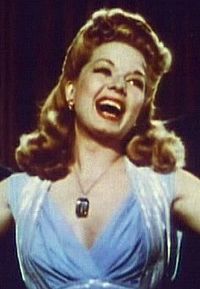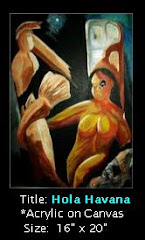As children of the 1950's, for my twin brother and I, 7 am on Saturday mornings invariably meant one of two things:
Gathering in front of the TV set in the living room to watch reruns of Red Ryder or (or better yet!), Rocky Jones -Space Ranger. Both shows were shown on alternating Saturday mornings for several years during the late 1950's in the Tampa-Bay TV market.

There were other space operas geared for juvenile audiences in those early days of TV, with Space Patrol and Captain Video probably the best remembered.
But both of these shows suffered from extremely low budgets; most were stage bound live productions with cardboard scenery and papier-mâché planets suspended by fishing line.
By contrast, Rocky Jones was filmed, and while these shows could never be described as big-budget productions, they did use exterior shots, matte background paintings, and remarkably good (for the times) special effects.
Some of the features of Rocky's ship would become staples of later science-fiction classics, like Star Trek.

The Orbit Jet

Rocky and Winky
The Wikipedia lists the Orbit Jet's advanced features as including:
- An electronic viewscreen (instead of a simple window or porthole)
- A fantastically complicated control panel (without an airplane-styled control wheel or stick)
- Power doors opening side-to-side as one approaches
- Subspace radio (the "Astrophone") that allowed instantaneous communications over interplanetary distances
- Artificial gravity as an explained feature and plot element
- A cloaking device that rendered the ship invisible.
Thirty-nine episodes of Rocky Jones were produced over a two-year period, starting in 1954. Nearly all of the 30 minute episodes were part of a 3-episode arc. Only 3 of the episodes were standalone stories.
Many of these 3-episode stories were combined later into syndicated movies, which is how I remember them - probably from around 1958 or 1959.
The plots were nonsense, of course, and there was very little `science' to be found in this fiction. But to a 6 year old, in an age before John Glenn orbited the earth, these were wondrous tales indeed!
Each week Rocky and crew would blast off to strange worlds, usually `moons', with names like Fornax, Medina, and Cryko - where he would do battle with `space gangsters' or some evil Asteroid Queen.

Square jawed Richard Crane (June 6, 1918–March 9, 1969) played Rocky, a veteran actor with a long list of B credits to his name.
His career began in 1940 with a small role in Susan and God, and he worked steadily during the 1940's (often uncredited) in movies like So Proudly We Hail, Flying Tigers, This is the Army, and Keep em Flying.
In the early 1950's Crane worked in several serials, including Commando Cody: Sky Marshal of the Universe. After Rocky Jones, Crane worked steadily in television, mostly as a supporting actor.
He became a semi-regular on Surfside-6, and was featured several times on 77 Sunset Strip. His last role was on Adam-12. Crane died of a heart attack in 1969, at the age of 50.
Rocky's co-pilot and sidekick (everyone had a sidekick!) was Winky, played by Scotty Beckett (October 4th, 1929 - May 10th, 1968).

Scotty Beckett was one of the most promising young actors in Hollywood during the 1930's and 1940's. His career began at the age of 3, playing in the Our Gang series. After 15 of these comedy shorts (1934-1935), Beckett graduated to feature films.
Among his major credits were
Dante's Inferno (1935)
Anthony Adverse (1936)
The Charge of the Light Brigade (1936)
Conquest (1937)
Marie Antoinette (1938)
My Favorite Wife (1940)
Kings Row (1942)
Unlike many child stars, he managed to keep on working even after adolescence.
My Reputation (1946)
The Jolson Story (1946)
Cynthia (1947)
Battleground (1949)
Nancy Goes to Rio (1950)
The Happy Years (1950)
While his career was thriving, his personal life began to unravel. In 1948 he was arrested for drunk driving and resisted arrest.
In September of 1949 he eloped with tennis star Beverly Baker, only to end in a very nasty, and public, divorce the next year.
In 1951 he began dating a young actress named Sunny Vickers. She became pregnant, and they married in 1951. His reputation as a `bad boy' made him a Hollywood outcast.
Roles were offered less frequently, and while his contemporaries, like Jane Powell and Elizabeth Taylor continued to see their careers flourish, Beckett was lucky to get a supporting role in a syndicated kids TV show.
In the second year of Rocky Jones, Beckett apparently became involved in an armed hotel robbery, and after posting bail, fled with his wife and 3-year old son to Mexico. There he passed some bad checks, and was involved in a shootout with Mexican authorities.
Beckett seemed on the road to recovery by 1957, but was arrested bringing illegal drugs into the country from Mexico. In 1959 he wrecked his car (alcohol was involved), crippling himself for life. During the 1960's, he would be arrested several more times, and in 1968 died from an overdose of barbiturates.
A sad and tragic end to such a promising young actor.
Sally Mansfield (born Marie Mahder 1923-January 28th, 2001) played the role of Vena Ray the navigator and assistant aboard the United Worlds rocket ships Orbit Jet .
A contract player for Paramount, Sally was chosen from a field of 300 applicants for the role. Prior to Rocky Jones, she had appeared in a handful of television productions.

Mansfield added some much needed estrogen to the Rocky Jones shows, giving young girls a role model (and some eye candy for older boys!).
Mansfield would work in television for another 10 years, after the Rocky Jones show ended production, in shows like Grindl, McHale's Navy, and The Donna Reed Show before retiring.
Sally Mansfield reportedly died of lung cancer in California in 2001 at the age of 78.

Robert Lyden, age 10, played young space cadet Bobby, who was basically there to give young kids someone to identify with. He made only a few more television and movie appearances after Rocky Jones, with the most notable one being his portrayal of a young Creighton Chaney in `Man of A Thousand Faces" with James Cagney.
Because these shows were done on film we still have many of these episodes available. If you can suspend disbelief for an hour or so, and ignore the juvenile plots and low budgets, they remain entertaining to this day.
At least, if you grew up with Rocky Jones and his crew.
Here are 4 of the re-edited Rocky Jones Movies. The descriptions are from the uploader at the Internet Archive.
![[movies]](http://www.archive.org/images/mediatype_movies.gif)
"Rocky Jones, Space Ranger" – Rocky's Odyssey (1954)
"Rocky Jones, Space Ranger" â Rocky's Odyssey (1954) Starring Richard Crane, Scotty Beckett and Sally Mansfield Chapter I, II & III aired weekly, beginning September 19, 1954. Reedited into feature length TV film "Gypsy moon".
![[movies]](http://www.archive.org/images/mediatype_movies.gif)
Rocky Jones, Space Ranger - Crash of the Moons - Arthur Pierson, Guy V. Thayer Jr.
Cruising the galaxy in his space ship "The Orbit Jet" Space Ranger, Rocky Jones (Richard Crane), Vena Ray (Sally Mansfield), Winky (Scotty Beckett) and 10 year-old Bobby (Robert Lyden) defend the Earth and themselves against space-bound evil doers. On the planet Ophesus, Rocky is involved in contentious negotiations with Cleolanta (Patsy Parsons), iron-fisted dictator/queen of this world. Along with Rocky are his co-pilot Winky and diplomat Drake (Charles Meredith), who is "Secretary of Space" f...
![[movies]](http://www.archive.org/images/mediatype_movies.gif)
Rocky Jones, Space Ranger - Menace from Outer Space - Arthur Pierson, Guy V. Thayer Jr.
Cruising the galaxy in his space ship "The Orbit Jet" Space Ranger, Rocky Jones (Richard Crane), Vena Ray (Sally Mansfield), and 10 year-old Bobby (Robert Lyden) defend the Earth and themselves against space-bound evil doers. A couple of missiles strike earth and Rocky and the gang go to find out where they are coming from. They end up on a moon of Jupiter which is perfect for their survival. They are lucky to land because they have run out of gas...
![[movies]](http://www.archive.org/images/mediatype_movies.gif)
“Rocky Jones, Space Ranger†– Beyond the curtain of space (1954)
âRocky Jones, Space Rangerâ â Beyond the curtain of space (1954) Chapter I, II & III aired weekly beginning April 10th, 1954. Reedited into feature length TV film âBeyond the moonâ. Half hour episodes were usually grouped into stories that consisted of three 'chapters' that were broadcast on successive weeks. A few of the stories were complete in one episode. Thirty six of these were grouped into 12 three-episode stories, and three were complete in one episode...
![[movies]](http://www.archive.org/images/mediatype_movies.gif)
![[movies]](http://www.archive.org/images/mediatype_movies.gif)




































